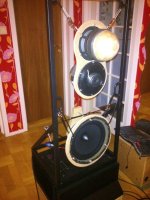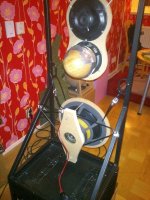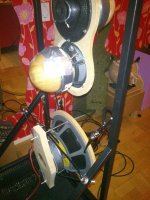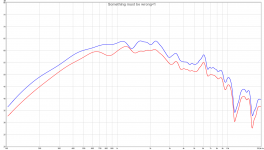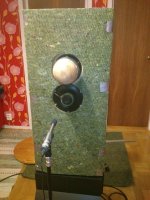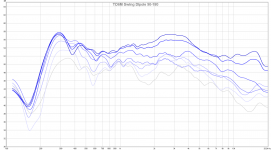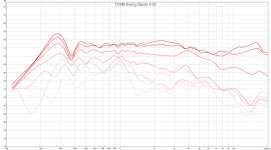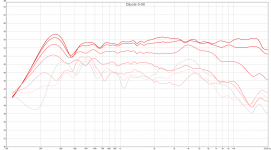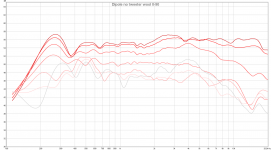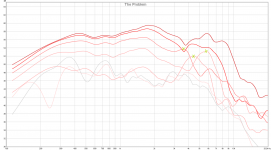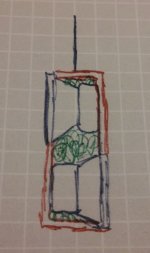For those wanting a ready-made frame for dipole experiments take a look at this bike rack . . . (there's a different-branded but apparently the same item at Amazon).
XPORT Bikes Aloft 2 Storage Rack - Bike Indoor Storage
I bought a pair of these yesterday for my current projects . . . at $60 each (black Friday sale price, through the weekend) they are a steal. Really solid, easy to assemble, wish they were black, but whatever . . .
XPORT Bikes Aloft 2 Storage Rack - Bike Indoor Storage
I bought a pair of these yesterday for my current projects . . . at $60 each (black Friday sale price, through the weekend) they are a steal. Really solid, easy to assemble, wish they were black, but whatever . . .
Yup, IKEA Blanda salad bowls =)
Haha nice! But hang on, won't the salad bowls cause backwave reflection problems / resonances? Or is the wavelength too small to be an issue for these bigger drivers? I have in my notes the idea of using a three-layer wool cone on the back of each driver to attenuate the back wave, avoiding the reflection problems caused by e.g. the B&W style cone. Are you doing a flat wool baffle through all the drivers?
I was recently thinking of trying that cone thing with either Linkwitz's LX521 driver arrangement or a Neo3 + Neo10 + woofer array. Very curious about the wool thing.
Haha nice! But hang on, won't the salad bowls cause backwave reflection problems / resonances? Or is the wavelength too small to be an issue for these bigger drivers? I have in my notes the idea of using a three-layer wool cone on the back of each driver to attenuate the back wave, avoiding the reflection problems caused by e.g. the B&W style cone. Are you doing a flat wool baffle through all the drivers?
I was recently thinking of trying that cone thing with either Linkwitz's LX521 driver arrangement or a Neo3 + Neo10 + woofer array. Very curious about the wool thing.
I'm not sure the bowls are doing anything actually, I'll probably cover the magnet with wool anyway so I might just cut off the bowls if they don't affect the response.
The idea was to reduce diffraction of the front facing driver, but wool might do that good enough anyway. I will test to cover up the rear response of the driver slightly, the ideal would be if I could make an acoustical 1 khz lowpass filter since it is about then that the rear response becomes worse.
Just got it working and started to measure, but something is messed up... I can feel it!
I'm currently measuring only the midranges without wool and I haven't fetched the wheel thingy to do polars so this is at 0 degrees half a meter in front in red and ~ 180 degrees about half a meter in blue.
It just looks way too good, the driver null at 700 hz has disappeared and there are no significant nulls or peaks in the response at all. This is even without any EQ :O
I'm currently measuring only the midranges without wool and I haven't fetched the wheel thingy to do polars so this is at 0 degrees half a meter in front in red and ~ 180 degrees about half a meter in blue.
It just looks way too good, the driver null at 700 hz has disappeared and there are no significant nulls or peaks in the response at all. This is even without any EQ :O
Attachments
I guess it wasn't so good at all when I looked closer =)
While it looks nice on axis it didn't look as nice at 90 degrees, that 6 khz peak is omni and there was more dips and such.
It looks much better with the wool =) I wasn't happy with a 3.6 khz dip in the midrange response but that lessened significantly when I wrapped wool around the tweeter.
While it looks nice on axis it didn't look as nice at 90 degrees, that 6 khz peak is omni and there was more dips and such.
It looks much better with the wool =) I wasn't happy with a 3.6 khz dip in the midrange response but that lessened significantly when I wrapped wool around the tweeter.
Attachments
Meeeeh, I wanted the crossover to be as easy as possible but it looks like I'll have to do an 9 khz all pass filter on the tweeter too if I want it perfect.
Hopefully I'll be able to dial in that with a lattice topology =)
Hopefully I'll be able to dial in that with a lattice topology =)
Tomorrow I'll put the speaker on the wheel thingy so I can do true polars, it does look promising though on my approximate polars when moving the mic around.
The speaker weights more than me though so I'll need help to lift it 😛
The speaker weights more than me though so I'll need help to lift it 😛
Ollboll, your measuring distance is too close, to enable dipolic function. That's why you don't see dipole null. Distance should be minimally 2x baffle width, preferably even more at least 1,5 meters. I guess the weather does not permit outdoor measurements now, at least have snowstorm here!
I think it is wise to measure individual drivers (dipole pairs) first 0-180¤ and then of course fullrange with xrossover. You will find that it is rather difficult to have good phase match throughout the range.
I think it is wise to measure individual drivers (dipole pairs) first 0-180¤ and then of course fullrange with xrossover. You will find that it is rather difficult to have good phase match throughout the range.
Ollboll, your measuring distance is too close, to enable dipolic function. That's why you don't see dipole null. Distance should be minimally 2x baffle width, preferably even more at least 1,5 meters. I guess the weather does not permit outdoor measurements now, at least have snowstorm here!
I think it is wise to measure individual drivers (dipole pairs) first 0-180¤ and then of course fullrange with xrossover. You will find that it is rather difficult to have good phase match throughout the range.
Sounds reasonable, I should have enough distance to the walls to measure at 1.5 meters.
And since I've already measured the drivers before I skipped that step this time and instead dialed them in to acoustical LR2 @ 3 khz which gets them to sum fairly ok on and off axis.
Of what I tested with the delay it wasn't a free lunch though, if I used delay to make the 0-60 degree response close to perfect the 75 was worse and got large peaks and dips. It is to be expected though and is probably worth it in the end.
But before I test further I'll have to get that wheel thingy and get some real measurements =)
Measurements done at 1.5 m with 11 ms window.
First polar done: each step is 15 degrees, and grey is at 90. It's not perfectly at 90 degrees since the balance on my wheel thingy won't permit that but close enough.
One sheet of wool in this test, I'll have to test with two sheets to see if the 1 khz anomaly disapperars.
Apart from that it's pretty good, front vs back dispersion is about +- 2 dB which ought to be good enough. 0-60 looks good also which is probably the most important part. It's not as good as my test before though without dual mids so I'll have to tinker some more.
First polar done: each step is 15 degrees, and grey is at 90. It's not perfectly at 90 degrees since the balance on my wheel thingy won't permit that but close enough.
One sheet of wool in this test, I'll have to test with two sheets to see if the 1 khz anomaly disapperars.
Apart from that it's pretty good, front vs back dispersion is about +- 2 dB which ought to be good enough. 0-60 looks good also which is probably the most important part. It's not as good as my test before though without dual mids so I'll have to tinker some more.
Attachments
Last edited:
Here is without the wool around the tweeter, so I guess tweeter wool was a good thing =)
It's not a big difference though, but significant enough to warrant it.
I'll try to see if I can remove the 4 khz bump that I think comes from the rear of the midrange, if I succeed with that then I think I'm home with the major fixes.
It's not a big difference though, but significant enough to warrant it.
I'll try to see if I can remove the 4 khz bump that I think comes from the rear of the midrange, if I succeed with that then I think I'm home with the major fixes.
Attachments
Last edited:
This isn't working : /
The baffle itself works wonders but that midrange isn't suited for back to back operation. In the single driver case I could use the driver basically full range on the front, and it worked wonders. The rear dispersion wasn't as good but it wasn't bad so it's ok. The problem was just the 1.5 - 2 khz dip where the rear dispersion of the mid falls off.
I hoped that two midranges mounted on opposite sides of the baffle also could be used full range and that the front facing driver dominates the treble enough that the rear facing driver doesn't matter. This, however, was an utopic assumption : /
Here we have only the mid full range, the response is flawless up to 3 khz but above that there is ugly peaks in the off axis repsonse so the rear of this driver isn't usable full range.
What to do? I've thought of two ideas:
#1 Backtrack to a single midrange as before but augment the rear tweeter with the waveguide to lessen the 2 khz dip. It should probably work, in that case the front dispersion would be as before and the rear dispersion would be not bad. The problem with this solution is that the mechanical balance would not be in the center so I'd have to solve that.
#2 Build a sealed enclosure for the midrange drivers, like in the picture and stuff it full of wool. If I'm not mistaken the drivers should sum acoustically at low frequencies which is nice. At higher frequencies they would not but at those the wool will dampen them and it's not as likely that they will penetrate the cone of the other driver and leak out anyway which is also nice.
I guess I'll have to try both...
Or maybe you have some ideas? 😉
The baffle itself works wonders but that midrange isn't suited for back to back operation. In the single driver case I could use the driver basically full range on the front, and it worked wonders. The rear dispersion wasn't as good but it wasn't bad so it's ok. The problem was just the 1.5 - 2 khz dip where the rear dispersion of the mid falls off.
I hoped that two midranges mounted on opposite sides of the baffle also could be used full range and that the front facing driver dominates the treble enough that the rear facing driver doesn't matter. This, however, was an utopic assumption : /
Here we have only the mid full range, the response is flawless up to 3 khz but above that there is ugly peaks in the off axis repsonse so the rear of this driver isn't usable full range.
What to do? I've thought of two ideas:
#1 Backtrack to a single midrange as before but augment the rear tweeter with the waveguide to lessen the 2 khz dip. It should probably work, in that case the front dispersion would be as before and the rear dispersion would be not bad. The problem with this solution is that the mechanical balance would not be in the center so I'd have to solve that.
#2 Build a sealed enclosure for the midrange drivers, like in the picture and stuff it full of wool. If I'm not mistaken the drivers should sum acoustically at low frequencies which is nice. At higher frequencies they would not but at those the wool will dampen them and it's not as likely that they will penetrate the cone of the other driver and leak out anyway which is also nice.
I guess I'll have to try both...
Or maybe you have some ideas? 😉
Attachments
A setback! I'll wait for someone more experience to chime in with ideas... but you inspired me to make a quick wool baffle Photoshop mockup using BG Neo 10/3 drivers. Interested in making some studio monitors like this using the wool baffle concept. Beware crappy Photoshop skills!
I'm thinking small wool baffle combined with wool cones on the back of each driver. Front wool baffle may have to be larger to do anything.
An externally hosted image should be here but it was not working when we last tested it.
I'm thinking small wool baffle combined with wool cones on the back of each driver. Front wool baffle may have to be larger to do anything.
A setback! I'll wait for someone more experience to chime in with ideas... but you inspired me to make a quick wool baffle Photoshop mockup using BG Neo 10/3 drivers. Interested in making some studio monitors like this using the wool baffle concept. Beware crappy Photoshop skills!
An externally hosted image should be here but it was not working when we last tested it.
I'm thinking small wool baffle combined with wool cones on the back of each driver. Front wool baffle may have to be larger to do anything.
Cool!
About that, one thing I noticed is that you don't need much wool at all. For me it's enough to have a single sheet of wool to get basically all the efficiency benefits. You'd think that the lower frequencies would just plow through but it works down there too =)
You mean a single sheet of wool as the main baffle or behind each driver? And how thick is the wool you're using?
"the response is flawless up to 3 khz but above that there is ugly peaks in the off axis repsonse so the rear of this driver isn't usable full range.
That looks like dipole null around 3,5kHz and typical comb filtering above it. Below 3kHz you have typical constant directivity of a dipole at it's dipole range.
Dipoles and Open Baffles
The frequency of dipole peak and null is determined by the smallest diameter of baffle. Some of your early felt measurements "make dipole peak and null disappear" obviously because you measure at too close (considering the widened baffle). I was wondering of this earlier but your photo of measuring setup revealed that. Now, when you have eq'd response you will see the dirver loosing it's directivity at and above dipole null
One of other graphs shows dipole peak around 800Hz, the bigger driver obviously. Where are xos?
That looks like dipole null around 3,5kHz and typical comb filtering above it. Below 3kHz you have typical constant directivity of a dipole at it's dipole range.
Dipoles and Open Baffles
An externally hosted image should be here but it was not working when we last tested it.
The frequency of dipole peak and null is determined by the smallest diameter of baffle. Some of your early felt measurements "make dipole peak and null disappear" obviously because you measure at too close (considering the widened baffle). I was wondering of this earlier but your photo of measuring setup revealed that. Now, when you have eq'd response you will see the dirver loosing it's directivity at and above dipole null
One of other graphs shows dipole peak around 800Hz, the bigger driver obviously. Where are xos?
You mean a single sheet of wool as the main baffle or behind each driver? And how thick is the wool you're using?
A single sheet of 8 mm thick wool as the only baffle. The only purpose of the mini wood baffles I built was to make it easier to mount the wool. In my next iteration I'll probably skip that baffle too and mount the wool directly on the driver as I did before.
- Status
- Not open for further replies.
- Home
- Loudspeakers
- Multi-Way
- Dipole wool carpet baffle experiment
